Knights of Columbus
The Knights of Columbus is the world's
largest Catholic fraternal service organization. Founded
in the United States in 1882, it is named in honor of
Christopher Columbus.
There are more than 1.7 million members in 14,000
councils, with nearly 200 councils on college campuses.
Membership is limited to "practical Catholic" men aged
18 or older.
Councils have been chartered in the United States,
Canada, Mexico, the Caribbean, Central America, the
Philippines, Guam, Saipan, Japan, Cuba, and most
recently in Poland. The Knights' official junior
organization, the Columbian Squires, has over 5,000
Circles. All the Order's ceremonials and business
meetings are restricted to members though all other
events are open to the public. A promise not to reveal
any details of the ceremonials except to an equally
qualified Knight is required to ensure their impact and
meaning for new members; an additional clause
subordinates the promise to that Knight's civil and
religious duties.
In the 2007 fraternal year the Order gave US$
144,911,781 directly to charity (1.1 Billion in
charitable contributions in the last 10 years) and
performed over 68,695,768 man hours of voluntary
service. For their support for the Church and local
communities, as well as for their philanthropic efforts,
the Order often refers to itself as the "strong right
arm of the Church" . The Order's insurance program has
more than $60 billion of life insurance policies in
force and holds the highest insurance ratings given by
A. M. Best, Standard & Poor's, and the Insurance
Marketplace Standards Association.
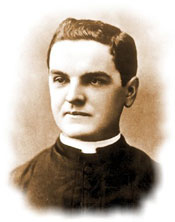 |
The Venerable Father Michael
J. McGivney, founder of the Knights of Columbus.
The Knights of Columbus was founded by an
Irish-American Catholic priest, The Venerable
Father Michael J. McGivney in New Haven,
Connecticut. He gathered a group of men from St.
Mary's parish for an organizational meeting on
October 2, 1881 and the Order was incorporated
under the laws of the U.S. state of Connecticut
on March 29, 1882. Though the first councils
were all in that state, the Order spread
throughout New England and the United States in
subsequent years. |
The primary motivation for the Order
was to be a mutual benefit society. As a parish priest
in an immigrant community, McGivney saw what could
happen to a family when the breadwinner died and wanted
to provide insurance to care for the widows and orphans
left behind. He himself had to temporarily leave his
seminary studies to care for his family when his father
died. In the late 19th century, Catholics were regularly
excluded from labor unions and other organizations that
provided social services.
In addition, Catholics were either
barred from many of the popular fraternal organizations,
or, as in the case of Freemasonry, forbidden from
joining by the Catholic Church itself. McGivney wished
to provide them an alternative. He also believed that
Catholicism and fraternalism were not incompatible and
wished to found a society that would encourage men to be
proud of their American-Catholic heritage.
McGivney traveled to Boston to examine the Massachusetts
Catholic Order of Foresters and to Brooklyn to learn
about the recently established Catholic Benevolent
League, both of which offered insurance benefits. He
found the latter to be lacking the excitement he thought
was needed if his organization were to compete with the
secret societies of the day. He expressed an interest in
establishing a New Haven Court of the Foresters, but the
charter of Massachusetts Foresters prevented them from
operating outside their Commonwealth. The committee of
St. Mary's parishioners McGivney had assembled then
decided to form a club that was entirely original.
McGivney had originally conceived of the name "Sons of
Columbus" but James T. Mullen, who would become the
first Supreme Knight, successfully suggested that
"Knights of Columbus" would better capture the
ritualistic nature of the new organization. The Order
was founded 10 years before the 400th anniversary of
Columbus' arrival in the New World and in a time of
renewed interest in him. Columbus was a hero to many
American Catholics, and the naming him as patron was
partly an attempt to bridge the division between the
Irish-Catholic founders of the Order and Catholic
immigrants of other nationalities living in Connecticut.
|
Christopher Columbus is the
patron and namesake of the Knights. |
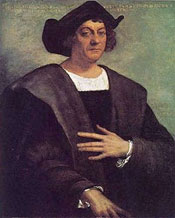 |
The Connecticut
Catholic ran an editorial in 1878 that
illustrated the esteem in which American
Catholics held Columbus. "As American Catholics
we do not know of anyone who more deserves our
grateful remembrance than the great and noble
man - the pious, zealous, faithful Catholic, the
enterprising navigator, and the large-hearted
and generous sailor: Christopher Columbus." |
The name of Columbus was also
partially intended as a mild rebuke to Anglo-Saxon
Protestant leaders, who upheld the explorer (a Catholic
Genovese Italian working for Catholic Spain) as an
American hero, yet simultaneously sought to marginalize
recent Catholic immigrants. In taking Columbus as their
patron, they were sending the message that not only
could Catholics be full members of American society, but
were, in fact, instrumental in its foundation.
By the time of the first annual convention in 1884, the
Order was prospering. In the five councils throughout
Connecticut were 459 members. Groups from other states
were requesting information. The Charter of 1899
included four statements of purpose, including "to
promote such social and intellectual intercourse among
its members as shall be desirable and proper, and by
such lawful means as to them shall seem best." The new
charter showed members' desire to grow the organization
beyond a simple mutual benefit insurance society.
The original insurance system devised by McGivney gave a
deceased Knight's widow a $1,000 death benefit. Each
member was assessed $1 upon a death and when the number
of Knights grew beyond 1,000 the assessment decreased
according to the rate of increase. Each member,
regardless of age, was assessed equally. As a result,
younger, healthier members could expect to pay more over
the course of their lifetimes than those men who joined
when they were older. There was also a Sick Benefit
Deposit for members who fell ill and could not work.
Each sick Knight was entitled to draw up to $5 a week
for 13 weeks (roughly equivalent to $125.75 in 2009
dollars). If he remained sick after that the council to
which he belonged regulated the sum of money given to
him.
Today there are more than 14,000 councils around the
world and the Knights of Columbus is a multi-billion
dollar non-profit charitable organization. Knights may
be seen distributing Tootsie Rolls to raise funds to
fight developmental disabilities, volunteering for the
Special Olympics and other charitable organizations,
erecting pro-life billboards and "Keep Christ in
Christmas" signs, conducting blood drives and raising
funds for disaster victims, or parading at patriotic
events with their bright capes, feathered chapeaux, and
ceremonial swords. The cause for McGivney's canonization
is currently before the Congregation for the Causes of
Saints and a guild has been formed to promote his cause.
On March 15, 2008, Pope Benedict XVI approved a decree
recognizing the heroic virtue of Father Michael J.
McGivney, founder of the Knights of Columbus. The pope's
declaration significantly advances the priest's process
toward sainthood and gives the parish priest the
distinction of "Venerable Servant of God." If his cause
is successful, he will be the first priest born in the
United States to be canonized as a Saint.
|
Organization |
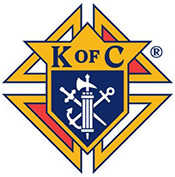 |
The Supreme Council is the governing
body of the Order and is composed of elected
representatives from each jurisdiction. The Supreme
Council acts in similar manner to shareholders at an
annual meeting and each year elects seven members to the
Supreme Board of Directors for three year terms. The
twenty-one member board then chooses from its own
membership the senior operating officials of the Order,
including the Supreme Knight.
State Councils in each of the 50 United States, each
province in Canada, and other jurisdictions carved out
of member countries are led by State Deputies and other
officers elected at state conventions. Territorial
Deputies are appointed by the Supreme Knight and lead
areas not yet incorporated into State Councils.
District Deputies are appointed by the Supreme Knight
upon the recommendation of the State Deputy and oversee
several local councils, each of which is led by a Grand
Knight. Other elected council officers include the
Deputy Grand Knight, Chancellor, Warden, Recorder,
Treasurer, Advocate, Guards and Trustees. A Chaplain is
appointed by the Grand Knight and a Financial Secretary
by the Supreme Knight. Council officers are properly
addressed by using the title "worthy" (e.g. Worthy Grand
Knight). Councils are numbered in the order in which
they chartered into the Order and are named by the local
membership. San Salvador Council #1 was named for the
first island Columbus landed on in the New World.
The title "Knight" is purely fraternal and is not the
equivalent to a sovereign accolade. Therefore Knights of
Columbus do not rank with Chevaliers and Commanders of
the Order of the Holy Sepulchre, the Order of Malta, the
Order of St. Gregory the Great, or members of any other
historic military or chivalric orders.
The Order is dedicated to the
principles of Charity, Unity, Fraternity and Patriotism.
A First Degree exemplification ceremony, by which a man
joins the Order, exemplifies the virtue of charity. He
is then said to be a First Degree Knight of Columbus and
after participating the subsequent degrees, each of
which focuses on another virtue, rises to that status.
Upon reaching the Third Degree a gentleman is considered
a full member. Priests do not participate directly in
Degree exemplifications as laymen do, but rather take
the degree by observation.
The first ritual handbook was printed in 1885 but
contained only sections teaching Unity and Charity.
Supreme Knight Mullen, along with primary ritual author
Daniel Colwell, believed that the initiation ceremony
should be held in three sections "in accord with the
'Trinity of Virtues, Charity, Unity, and Brotherly
love.'" The third section, expounding Fraternity, was
officially adopted in 1891.
|
Fourth Degree |
|
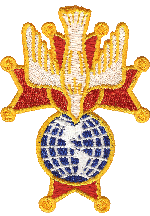 |
The Fourth Degree is the highest
degree of the order. Members of this degree are
addressed as "Sir Knight". The primary purpose of the
Fourth Degree is to foster the spirit of patriotism and
to encourage active Catholic citizenship. A Knight is
eligible to join the Fourth Degree after six months from
the date of his First Degree, providing he has completed
the 2nd and 3rd degrees beforehand.
Assemblies are distinct from councils and are led by a
separate set of elected officers. The Supreme Board of
Directors appoints a Supreme Master and twenty Vice
Supreme Masters to govern the Fourth Degree. Each Vice
Supreme Master oversees a Province which is then broken
up into Districts. The Supreme Master appoints District
Masters to supervise several assemblies.
Each assembly is led by a Navigator. Other elected
assembly officers include the Captain, Admiral, Pilot,
Scribe, Purser, Comptroller, Sentinels and Trustees. A
Friar and Color Corps Commander are appointed by the
Navigator. Assembly officers are properly addressed by
using the title "faithful" (e.g. Faithful Navigator).
Assemblies are numbered in the order in which they
chartered into the Order and are named by the local
membership.
|
Knights of Columbus Insurance Program |
| |
|
Many early members were recent
immigrants who often lived in unsanitary conditions and
performed hazardous jobs for poor pay. Since its
founding, a primary mission of the Knights of Columbus
has been to protect families against the financial ruin
caused by the death of the breadwinner. While this
method originally was intended to provide a core group
of people who would support a widow and her children
after the death of their husband and father, it has
expanded into much more.
Today the Order offers a modern, professional insurance
operation with more than $70 billion of life insurance
policies in force as of 2009. Products include permanent
and term life insurance as well as annuities and long
term care insurance. Insurance sales grew 19% in 2004,
more than three times the rate of industry at large. The
Order holds $13 billion in assets and had $1.5 billion
in revenue and $71 million in profits in 2005. This is
large enough to rank 72nd on the A.M. Best list of all
life insurance companies in North America and places it
on the Fortune 1000 list of top companies. Only three
other insurers in North America have received the
highest ratings from both A. M. Best and Standard &
Poor's. The Order is certified by the Insurance
Marketplace Standards Association for ethical sales
practices.
Charity is the foremost principle of
the Knights of Columbus. In the 2005 fraternal year the
Order gave $136 million directly to charity and
performed over 63.2 million man hours in voluntary
service. Endowed funds of over $54 million support a
number of Church related causes.[26] A Knight's highest
duty is to assist the widow or orphan of a fallen
brother Knight.
The Knights have a tradition of supporting those with
physical and developmental disabilities. More than $382
million has been given over the past three decades to
groups and programs that support the intellectually and
physically disabled. One of the largest recipients of
funds in this area is the Special Olympics. In addition,
the Order's highest honor, the Gaudium et Spes Award,
was given with its $100,000 honorarium to Jean Vanier,
the founder of l'Arche, in 2005. L'Arche is a
faith-based network that provides care, in a community
setting, for people with severe developmental
disabilities.
The Vicarius Christi Fund has a corpus of $20 million
and has earned more than $35 million, since its
establishment in 1981, for the Pope's personal
charities. The multimillion dollar Pacem in Terris Fund
aids the Catholic Church's efforts for peace in the
Middle East. The Order also has eleven separate funds
totaling $18 million to assist men and women who are
discerning religious vocations pay tuition and other
expenses.
Days after the terrorist attacks of September 11, 2001
the Order established the $1 million Heroes Fund.
Immediate assistance was given to the families of all
full-time professional law enforcement personnel,
firefighters and emergency medical workers who lost
their lives in the rescue and recovery efforts.
Orderwide, more than $10 million has been raised for
Hurricane Katrina relief efforts. On May 6, 2006, $3
million was disbursed to the Archdiocese of New Orleans
and the dioceses of Lafayette, LA, Houma-Thibodaux, LA,
Lake Charles, LA, Biloxi, MS and Beaumont, TX. The Order
also donated more than $500,000 to the Indian Ocean
Tsunami of 2004 relief efforts and $50,000 to help
victims of Typhoon Durian in the Philippines.
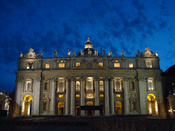 |
The Order funded the first
renovation of the facade of St. Peter's Basilica
in over 350 years.
At the 2006 American Cardinals Dinner, it was
announced that the Knights would be giving a
gift of $8 million to The Catholic University of
America. The gift is to renovate Kean Hall, |
an unused building, and rename
it McGivney Hall, after Fr. McGivney. The new McGivney
Hall will house the John Paul II Institute for Studies
on Marriage and Family, a graduate school of theology
affiliated with the Pontifical Lateran University in
Rome as well as CUA. Supreme Knight Anderson serves on
CUA's board of trustees and is the vice president of the
John Paul II Institute. The Knights have a long history
of donating to CUA.
The Knights' Satellite Uplink Program has
provided funding to broadcast a number of papal events
including the annual Easter and Christmas Masses, as
well as the World Day of Peace in Assisi, the Peace
Summit in Assisi, World Youth Days, the opening of the
Holy Door at St. Peter's Basilica's for the Millennial
Jubilee, Pope John Paul II's visit to Nazareth and
several other events. In missionary territories the
Order also pays for the satellite downlink.
United in Charity, a general, unrestricted endowment
fund, was introduced at the 2004 Supreme Council meeting
to support and ensure the overall long-term charitable
and philanthropic goals of the Order. The fund is wholly
managed, maintained and operated by Knights of Columbus
Charities, Inc., a 501(c)(3) charitable organization.
Before United in Charity was formed all requests for
funds were met with the general funds of the Order or in
combination with specific appeals. Requests from the
Church and organizations closely aligned with the
mission of the Order often far exceeded the amount
available and it is hoped that eventually United in
Charity's earnings will be sufficient to completely fund
the Order's charitable priorities.
Ever since its founding the Knights of Columbus has been
involved in evangelization. In 1948, the Knights started
the Catholic Information Service (CIS) to provide
low-cost Catholic publications for the general public as
well as for parishes, schools, retreat houses, military
installations, correctional facilities, legislatures,
the medical community, and for individuals who request
them. Since then, CIS has printed millions of booklets,
and thousands of people have enrolled in CIS
correspondence and on-line courses.
While most Knights of Columbus
Councils are located at parishes or near multiple parish
communities, many men first join the Knights while in
college. Over 14,000 Knights are members of 200+ College
Councils worldwide. College Knights are full members of
the Order.
The first College Council was at The Catholic University
of America, Keane Council 353 (it has since moved
off-campus). Today, the University of Notre Dame Knights
of Columbus Council 1477, founded in 1910, is the
longest-running college council in the country, followed
by the councils at St. Louis University and Benedictine
College.[32] In 1919, Mount St. Mary's College and
Seminary council 1965 became the first council attached
to a seminary, at what is now Mount St. Mary's
University. In 1937, the University of Illinois became
the first public university with a Knights of Columbus
Council, The Illini Council Number 2782.
Each September, the Supreme Council hosts a College
Council Conference at their headquarters in New Haven,
Connecticut. Awards are given for the greatest increases
in membership, the best Youth, Community, Council,
Family and Church activities and the overall Outstanding
College Council of the year. Belmont College and
Benedictine College lead the nation winning the most
titles of Outstanding College Council. In years of an
international World Youth Day the Order is represented
by members of the College Council Conference
Coordinating Committee, who travel with the diocese of
the Supreme Chaplain (currently Bishop William E. Lori
of the Diocese of Bridgeport).
|
Columbian Squires |
|
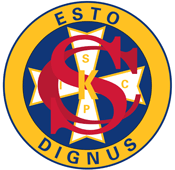 |
|
The Knights' official junior
organization is the Columbian Squires. The international
fraternity for boys 10–18 has over 5,000 circles.
According to Brother Barnabas McDonald, F.S.C., the
Squires founder, “The supreme purpose of the Columbian
Squires is character building.” Squires have fun and
share their Catholic faith, help people in need, and
enjoy the company of friends in social, family,
athletic, cultural, civic and spiritual activities.
Through their local circle, Squires work and socialize
as a group of friends, elect their own officers, and
develop into Catholic leaders.
Each Circle is supervised by a Knights of Columbus
Council or Assembly and has an advisory board made up of
either the Grand Knight, the Deputy Grand Knight and
Chaplain or the Faithful Navigator, the Faithful Captain
and Faithful Friar. Circles are either Council based,
parish based, or school based, depending on the location
of the circle and the Knight counselors.
|
Emblems Of The Order |
 |
Third Degree Emblem |
The emblem of the Order dates from the
second Supreme Council meeting on May 12, 1883, when
James T. Mullen, who was then supreme knight, designed
it.
The emblem indicates a shield mounted upon the Formee
cross (having the arms narrow at the center and
expanding toward the ends). The shield is that
associated with a medieval knight. The Formee cross is
the representation of a traditional artistic design of
the cross of Christ through which all graces of
redemption were procured for mankind. This then
represents the Catholic spirit of the Order.
Mounted on the shield are three objects: a fasces (a
bundle of rods bound together about an ax with the blade
projecting) standing vertically and, crossed behind it,
an anchor and a dagger or short sword. The fasces from
Roman days, carried before magistrates as an emblem of
authority, is symbolic of authority which must exist in
any tightly-bonded and efficiently operating
organization. The anchor is the mariner's symbol for
Columbus, patron of the Order, while the short sword or
dagger was the weapon of the Knight when engaged upon an
errand of mercy. Thus, the shield expresses Catholic
Knighthood in organized merciful action, and with the
letters, K of C, it proclaims this specific form of
activity.
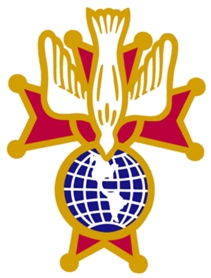 |
Fourth Degree Emblem |
The triad emblem of the Fourth Degree
features the dove, the cross and the globe. The dove,
classic symbol of the Holy Spirit and peace, is shown
hovering over the orb of the Earth (globe). Both are
mounted on a variation of the Crusader's cross, which
was found on the tunics and capes of the Crusading
knights who battled to regain the Holy Land from the
pagans.
Spiritually, the sacred symbols on the emblem typify the
union of the Three Divine Persons in one Godhead, the
most Blessed Trinity.
• The Globe -- God the Father, Creator of the Universe.
• The Cross -- God the Son, Redeemer of Mankind.
• The Dove -- God the Holy Spirit, Sanctifier of
Humanity.
The colors of the symbols are:
• A blue globe with the land of the Western Hemisphere
in white.
• A red cross with gold borders and gold knobs at the
end of the points forming the ends of the arms of the
cross, also known as the Isabella cross.
• A white dove.
Red, white and blue are the colors of the flag of the
country in which the Knights originated. They are used
to stress patriotism, the basic principle of the Fourth
Degree. |

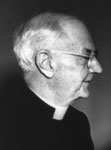

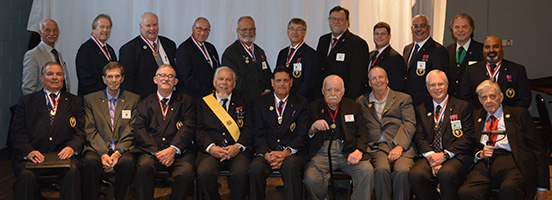







 Login Status
Login Status 